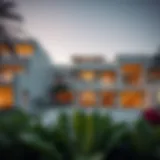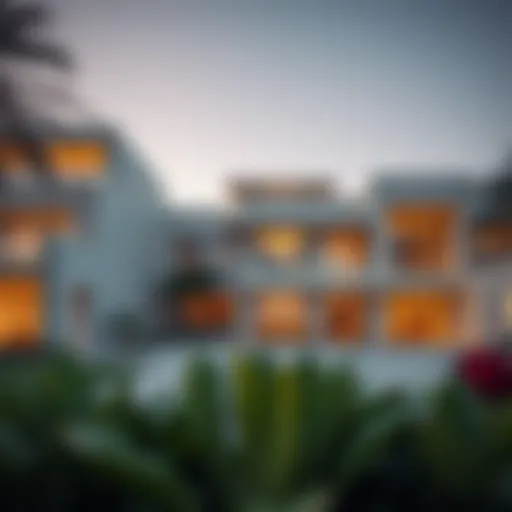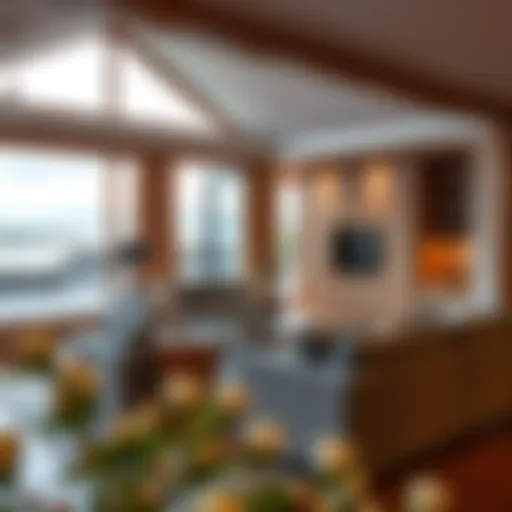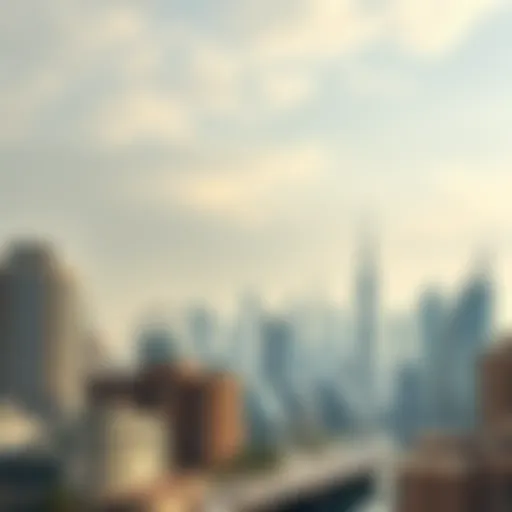Exploring Al Fakhama Tower: A Modern Dubai Icon
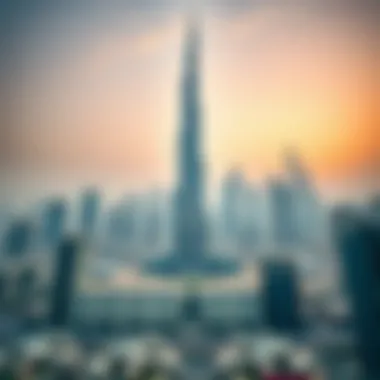

Intro
The Al Fakhama Tower, a striking addition to Dubai's skyline, stands as a symbol of innovation and modernity. As Dubai continues to redefine itself through ambitious architectural undertakings, this tower exemplifies the essence of contemporary design and its role in shaping urban landscapes. With a blend of aesthetics and functionality, the tower attracts both local and global investor interest. In this exploration, we will uncover the layers of this architectural marvel, delving into its design principles, economic implications, and future prospects.
Market Insights
Current Trends in Dubai Real Estate
Dubai’s real estate market has been nothing short of a roller coaster ride. With fluctuations often influenced by global economic factors, local policies, and changing consumer demands, the market remains dynamic. One notable trend is the surge in luxury properties, as affluent investors flock to opulent offerings. The Al Fakhama Tower, with its high-end apartments and state-of-the-art amenities, seamlessly fits into this market trajectory. Buyers are increasingly after unique properties that not only promise high returns but also embody a lifestyle statement.
- High Demand for Rentals: There’s a spike in demand for rental units, driven by an influx of expatriates and tourists.
- Sustainability Focus: Eco-friendly designs are gaining traction, as the market shifts towards sustainable living.
- Smart Technology Integration: Properties equipped with smart systems are commanding higher prices, reflecting buyer preferences for convenience and security.
Forecast for Property Prices
Looking ahead, property prices in Dubai are expected to follow an upward trajectory. The government's commitment to infrastructure growth and a favorable business environment fosters a climate ripe for investment. Experts predict that areas surrounding the Al Fakhama Tower might see increased valuations as surrounding amenities develop.
"The resurgence in Dubai’s property market symbolizes resilience and a forward-thinking approach that attracts global interest."
Investment Strategies
Tips for First-Time Buyers
Entering the Dubai property market can feel daunting, especially for newcomers. However, by adopting informed strategies, first-time buyers can make sound investments:
- Research Neighborhoods: Understand the different vibes of districts—each has its unique offerings.
- Set a Budget: Factor in not just the purchase price, but also maintenance fees, utilities, and other associated costs.
- Engage Local Experts: Rely on real estate agents who know the market inside out.
Diversifying Your Real Estate Portfolio
For seasoned investors, adding a property like the Al Fakhama Tower to their portfolio offers diversification benefits. Considerations include:
- Invest in Various Property Types: From commercial spaces to residential units, diverse holdings can hedge against market volatility.
- Geographical Spread: Invest in different locations within Dubai or even beyond to mitigate risks associated with single markets.
- Stay Informed: Keep an eye on trends, regulations, and market shifts to adapt your strategy accordingly.
The Al Fakhama Tower is not just another building; it’s a testament to the ongoing evolution of Dubai's real estate arena, promising growth, investment-smart strategies, and a legacy that captures the vibrancy of a city in perpetual motion.
Overview of Al Fakhama Tower
In the heart of Dubai’s bustling metropolis, the Al Fakhama Tower stands as more than just an architectural feat; it embodies the relentless spirit of innovation that has come to characterize the city. This overview elucidates the significance of the tower, not merely as a structure, but as a pivotal contributor to the economy, culture, and identity of Dubai. Enveloping modern aesthetics with functional design, this tower caters to a diverse range of stakeholders, including investors, residents, and tourists alike.
Location and Accessibility
The Al Fakhama Tower rests strategically within Dubai, a city known for its celebrated juxtaposition of tradition and modernity. Its proximity to pivotal landmarks, including the Dubai Mall and Burj Khalifa, positions it as a central hub for commerce and leisure.
Reaching the tower is a straightforward affair; its accessibility is facilitated by a network of efficient public transport systems, including the Dubai Metro and various bus routes. Additionally, main thoroughfares lead directly to its doorstep, ensuring that visitors can navigate the area effortlessly. As urban planners like to say, location is everything, and the Al Fakhama Tower exemplifies this principle.
Historical Context
Understanding the Al Fakhama Tower’s place in Dubai's architectural narrative requires a dive into the historical backdrop from which it emerged. The rapid transformation of this desert city from a small fishing community to a global epicenter for trade and tourism has been extraordinary. Each towering skyscraper, including Al Fakhama, tells a story of aspiration and metamorphosis.
As Dubai welcomed the 21st century, the demand for innovative living spaces and commercial opportunities spurred the development of structures that defy conventional architecture. The Al Fakhama Tower resonates with this narrative — born from a confluence of local traditions and cutting-edge technology. It stands as a testament to the ambitions of a nation that constantly seeks to redefine its skyline, offering both a nod to its rich heritage and a glimpse into its future.
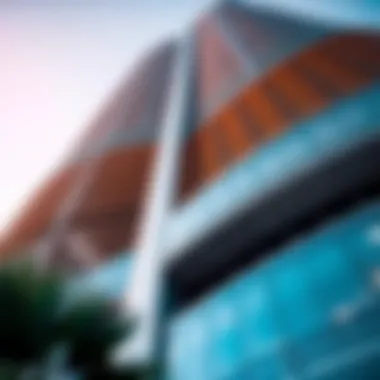

Architectural Design
The architectural design of the Al Fakhama Tower stands as a testament to modern engineering and aesthetic brilliance in Dubai's skyline. Architectural design is not merely about creating a structure; it revolves around integrating beauty, functionality, and the environment. The Al Fakhama Tower exemplifies this balance by showcasing innovative concepts and a thoughtful approach to the urban landscape.
Design Inspiration and Philosophy
The design of the Al Fakhama Tower borrows elements from diverse architectural styles. Drawing upon local heritage, its form reflects traditional Arabic motifs while incorporating sleek lines that resonate with contemporary aesthetics. The philosophy behind the design seems to revolve around cultural resonance and modern functionality.
"A structure must be more than a building; it should tell a story of its place and people."
In other words, the tower is not just an edifice; it embodies the spirit of Dubai's evolution from a humble port city into a symbol of modernity. This blending of influences caters to both residents and visitors, providing a unique sense of identity.
Structural Features
The structural integrity of the Al Fakhama Tower is pivotal to its standing. This skyscraper has a unique inclined silhouette that captures not just the sunlight, but also the attention of anyone gazing upon it. Key features include:
- Innovative use of materials: The combination of steel and glass creates a visually striking facade while ensuring longevity and safety.
- Smart design: The building incorporates state-of-the-art technology, including earthquake-resistant frameworks and energy-efficient systems that align with the current demands of urban living.
- Vertical gardens: Enhancements such as vertical gardens make the tower visually appealing while promoting sustainability by improving air quality and insolation.
Sustainability Considerations
Sustainability is woven into the very fabric of the Al Fakhama Tower. Its design principles consider the environmental impact, aiming to reduce the carbon footprint significantly. Factors contributing to sustainability include:
- Renewable energy sources: The tower integrates solar panels to harness sunlight, thus reducing dependency on conventional energy.
- Water management systems: Innovative systems for water conservation and recycling promote efficient usage, important in a desert environment.
- Community green spaces: The tower isn't just about luxury; it's about blending with nature. Green areas surrounding the building foster community engagement, enhancing the quality of life for residents and visitors.
Construction Process
The construction process of the Al Fakhama Tower stands as a testament to the intricate blend of creativity and engineering prowess. This phase is paramount, not just in bringing a visionary design to life, but also in addressing the multifaceted challenges inherent in modern architectural projects. Delving into this stage provides crucial insight into how such a monumental structure shapes the urban landscape and contributes to Dubai's status as a global architectural leader.
Timeline of Construction
The construction timeline for the Al Fakhama Tower was meticulously planned, reflecting extensive coordination between various stakeholders. Groundbreaking began in early 2020, kicking off a whirlwind of activity that transformed the plot into the iconic skyscraper it stands today. The project adhered to a phased approach:
- Groundworks and Foundation (2020 - early 2021): Before laying the first brick, extensive excavation was vital to ensure a robust foundation. This part of the process was crucial in guaranteeing stability in Dubai's sandy soil.
- Structural Framework (mid-2021 - 2022): This phase saw the rise of the tower, where steel and concrete were used to create the skeleton of the building, reached its height swiftly yet precisely.
- Exterior Finishing (2022 - early 2023): The outside cladding and installations came next, ensuring not just an aesthetic appeal but also durability against local environmental factors.
- Interior Work and Landscaping (2023): Finally, the inside spaces were crafted to enhance both functionality and comfort; landscaping around the structure integrated greenery into the urban setting.
The building was officially completed in late 2023, with its grand opening marking a significant milestone in Dubai’s skyline.
Materials Used
The selection of materials for the Al Fakhama Tower was far from arbitrary; it was a reflection of both innovation and sustainability. Key materials included:
- High-Strength Concrete: Essential for structural integrity, this material was used in the foundation and core of the tower, ensuring it could withstand the various stresses of nature and time.
- Glass Panels: The facade incorporated cutting-edge glass technology that not only provides breathtaking views of the city but reflects sunlight, contributing to energy efficiency.
- Steel Beams: These created the building's supportive framework, chosen for their durability and ability to help shape the tower's unique design features.
- Recycled Materials: Emphasizing sustainability, recycled components were integrated into the non-structural parts of the construction, demonstrating a commitment to environmental stewardship.
By opting for these materials, the construction team prioritized not just elegance and modernity but also durability.
Challenges Faced During Construction
No grand architectural endeavor is without its hurdles. During the construction of the Al Fakhama Tower, several notable challenges arose:
- Extreme Weather Conditions: Dubai’s notorious heat posed a challenge, requiring work schedules to be adjusted to avoid midday sun.
- Supply Chain Interruptions: As with many global projects, material delivery faced disruptions due to pandemic-related restrictions, which necessitated quick problem-solving to keep the timeline on track.
- Design Adjustments: Midway through the process, there were essential revisions to certain design elements to enhance functionality, requiring re-evaluation and alterations to construction methods.
- Safety Protocols: Maintaining safety standards was paramount. The team implemented rigorous protocols to minimize risks, ensuring a secure working environment for all personnel.
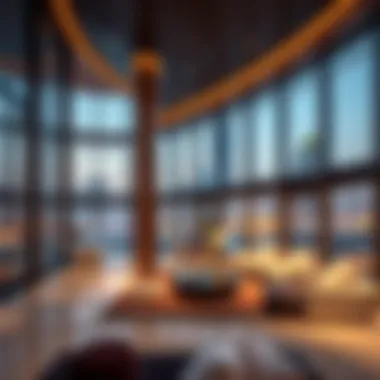
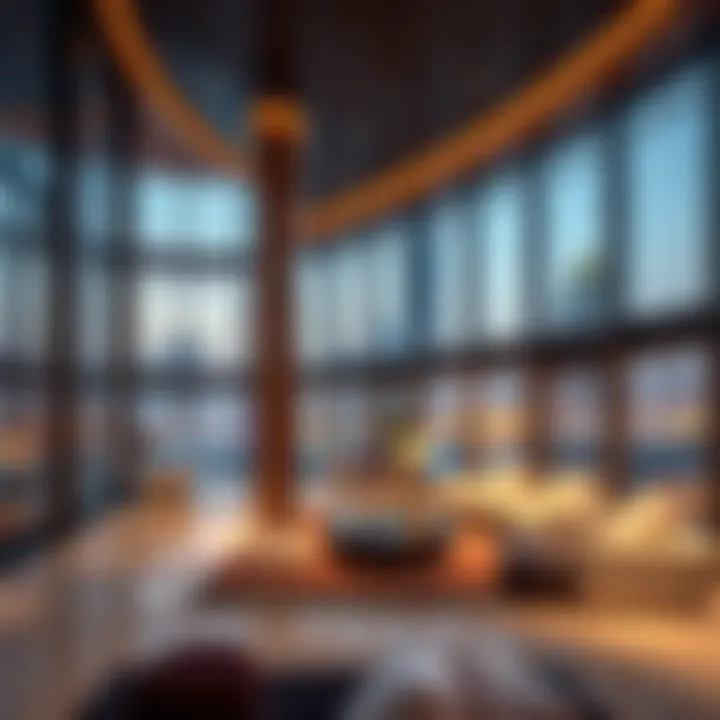
Despite these hurdles, the successful navigation of these challenges exemplifies the resilience and commitment of the teams involved.
The construction of the Al Fakhama Tower was not just about erecting a building; it was an intricate dance of engineering precision and resource management that ultimately led to an architectural triumph in Dubai.
This phase of the project reaffirms that the journey from blueprint to reality is a complex, yet rewarding process that shapes both the skyline and the community in profound ways.
Real Estate Impact
The rise of Al Fakhama Tower undeniably reshapes the real estate scene in Dubai. It serves not just as a striking landmark, but also as a catalyst for real estate dynamics that affects property values and urban development in its vicinity. Investors and homebuyers alike put a premium on proximity to such iconic structures, recognizing their potential to uplift both lifestyle and equity in property holdings.
Market Trends Following Tower Completion
Since the completion of Al Fakhama Tower, the surrounding area has seen a notable shift in market trends. Real estate prices have surged, responding to increased demand fueled by the tower’s modern allure. The influx of visitors and potential residents has prompted a broader interest in properties nearby, often leading to bidding wars among prospective buyers. According to local agencies, average property prices in the vicinity rose by 12% in the first year after the tower’s opening alone.
Given this enthusiasm, developers are keen to roll out new projects aiming to take advantage of the heightened demand. Many are focusing on luxury condominiums and high-end retail spaces that align with the lifestyle of individuals likely to occupy or visit Al Fakhama Tower.
Investment Opportunities
With Al Fakhama Tower standing tall, investment opportunities have blossomed in the neighborhood. Real estate firms are actively promoting available properties; from commercial spaces that cater to the affluent crowd, to residential units aimed at families and professionals. This boom isn’t limited to physical properties alone; it extends to real estate investment trusts (REITs) focusing on Dubai, which are drawing interest due to their potential for steady returns.
Investors should consider looking into:
- Property Flipping: Buying units at a lower price and reselling once the area matures in value.
- Rental Investments: Units near the tower have a higher chance of attracting tenants at the favored price, especially from expatriates or business travelers.
- Commercial Leasing: Businesses targeting tourists or residents are eyeing spaces within the vicinity, thus making commercial properties hot commodities.
Attraction for Foreign Investors
The Al Fakhama Tower has also become a beacon for foreign investors. Many see Dubai as a robust market for real estate investment due to its favorable tax regime and relatively high rental yields compared to other global cities. The tower itself symbolizes a new age of architectural splendor, catalyzing interest from overseas buyers looking for a piece of Dubai’s luxury lifestyle.
Furthermore, the international appeal of the location is attracting not just residential investors but also businesses looking to establish a footprint in a growing market. With transportation links improving and amenities expanding, foreign investors are enticed by the prospect of long-term value appreciation. An analysis from the Dubai Land Department shows that foreign investments in the sector grew by nearly 25% in the year following the tower's opening, highlighting the attraction of such a landmark.
"Al Fakhama Tower has consistently drawn international attention, proving that excellent design can drive economic success."
As the global real estate landscape evolves, so do the opportunities surrounding architectural marvels like Al Fakhama Tower, making it crucial for investors to keep an eye on emerging trends and opportunities in the vicinity.
Community and Cultural Influence
The Al Fakhama Tower is more than just a skyscraper; it stands as a beacon of community and cultural significance within Dubai. In the bustling life of this metropolis, where cultures collide and blend, the tower plays an integral role in shaping the urban identity of the area. Its very presence prompts conversations about the future of urban development, inviting both locals and visitors to reflect on how architecture can enhance community life.
Role in Urban Development
The Al Fakhama Tower is strategically placed within a rapidly changing cityscape. It not only signifies architectural innovation but also embodies a focal point for urban revitalization. Located close to busy transportation hubs, commercial areas, and recreational spaces, it serves as a catalyst for economic activity and social cohesion. The tower’s modern façade contributes to the skyline while reinforcing the city's image as a global hub.
Factors like the following contribute to its role in urban development:
- Economic Opportunities: By drawing both businesses and consumers, it functions as an economic engine, fostering job creation and boosting local businesses around its vicinity.
- Cultural Symbol: The design elements and public spaces within the tower resonate with Dubai’s rich cultural heritage, encouraging a sense of belonging among residents while also attracting tourists eager to experience something unique.
- Sustainable Urban Living: As more individuals prioritize living close to work and leisure opportunities, the tower promotes a walkable lifestyle. This interconnectedness aligns with contemporary urban planning goals aimed at reducing dependence on vehicles.
Community Engagement Initiatives
Beyond the bricks and mortar, Al Fakhama Tower actively engages the community in various pursuits that uplift social connectivity and cultural exchange. Several initiatives have been rolled out to ensure that the area fosters inclusivity and collaborative spirit.
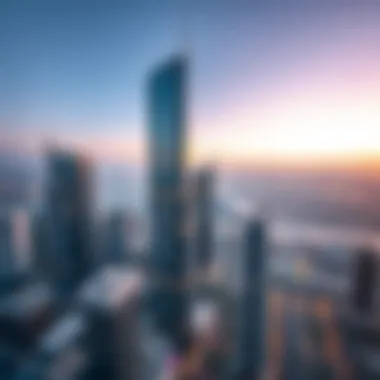
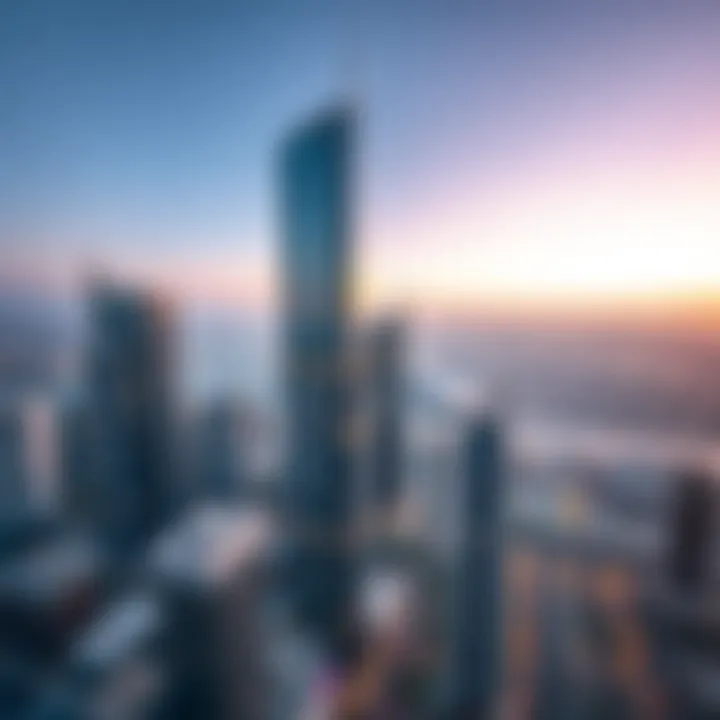
- Local Art Exhibitions: Regularly hosting exhibitions that spotlight local artists gives them a platform to showcase their talent while providing residents with an appreciation of their cultural landscape.
- Public Events: The tower often organizes community events such as workshops, health fairs, and cultural festivals, which invite active participation and facilitate conversations among community members.
- Partnerships with Local Schools: Collaborating with educational institutions, the tower supports programs that encourage students to participate in architectural workshops or design competitions, thus enthusing the next generation about urban development.
"Through these community outreach efforts, Al Fakhama Tower is not merely a structure, but a vital part of the socio-cultural fabric of Dubai."
In a place like Dubai, known for its transient nature, the Al Fakhama Tower proves that connection and community are what ultimately brings vibrancy to an urban space. As it continues to evolve, its impact on cultural and communal engagement will likely inspire similar developments across the globe, making it a pivotal example of how architecture and society can harmonize.
Future Prospects
As we peer into the horizon of Al Fakhama Tower, one can’t help but acknowledge the anticipation that surrounds its future. This tower isn't merely a structure; it symbolizes growth, ambition, and a reflection of the economic aspirations embedded deeply within Dubai's identity. Understanding the future prospects of Al Fakhama Tower is crucial as it not only highlights the tower’s growing significance but also sheds light on the evolving landscape of Dubai’s real estate market.
Predicted Market Growth
The trajectory for the property market in Dubai appears promising, with Al Fakhama Tower at the center of it all. As new developments rise, there is an increasing demand for luxury residences and commercial spaces, which are crucial for investors seeking profitable returns.
A few key factors contribute to this predicted market growth:
- Increasing Foreign Investment: Dubai continues to draw attention from international investors. The allure of a modern lifestyle paired with progressive regulations fosters an inviting environment for overseas investors.
- Infrastructure Expansion: Recent enhancements in transportation and accessibility around the Al Fakhama Tower bolster its appeal. New metro lines and road projects can drastically reduce travel times, making the area more attractive for both residents and businesses.
- Tourism Surge: With events like Expo 2020 and similar international showcases, tourism has surged. This brings about a ripple effect on the housing market, contributing significantly to the demand for spaces near iconic landmarks like Al Fakhama Tower.
The predictions suggest not just incremental growth but a robust flourishing of the market, breathing life into the already vibrant character of Dubai.
Potential Developments in Surrounding Areas
The vibrancy of Al Fakhama Tower will likely catalyze a plethora of developments nearby. Real estate isn’t an isolated phenomenon; it operates in a network of interdependent factors that contribute to urban growth. As attention pivots to this architectural marvel, we can foresee several potential developments:
- Mixed-use Complexes: With family-friendly amenities and commercial outlets taking center stage, new mixed-use developments might spring up. They would cater to a blend of lifestyles, enabling seamless integration of work and leisure.
- Green Spaces and Parks: Sustainability is gaining traction, and nearby green spaces can become essential components of the community. Parks and recreational areas invite social interaction, thus enhancing the neighborhood’s quality of life, making it more attractive for families.
- Smart City Solutions: Anticipating the future tech needs, developments that incorporate smart city principles can improve efficiencies. Efficient energy management, smart transportation systems, and tech-centric amenities may likely become common features.
In summary, the future prospects of Al Fakhama Tower are bright, potentially leading to a rejuvenated market that continues to draw investment, stimulate growth, and redefine urban living in Dubai.
"The real estate market around Al Fakhama Tower is on the cusp of revolutionary changes that will reshape how people live and work in Dubai."
For more information on real estate trends in Dubai, check out Dubai Land Department or explore insights on urban development from Gulf News.
Continuing to watch these developments as they unfold around Al Fakhama Tower is essential for stakeholders invested in this architectural gem. The interplay between such a landmark and its surrounding environment will determine the future dynamics of Dubai's skyline and its global standing.
Finale
In examining the Al Fakhama Tower, it becomes clear that this architectural feat is not just a structure but a significant contributor to the urban landscape of Dubai. The design and execution of the tower represent a blend of modern ingenuity and cultural inspiration. As a towering symbol of prosperity and innovation, the Al Fakhama Tower serves several important purposes within the broader context of Dubai's growth.
Summary of Key Insights
The exploration of the Al Fakhama Tower highlights several key points that underline its significance:
- Architectural Innovation: The design reflects a unique philosophy, weaving together aesthetics and functionality. It stands distinct in a city filled with architectural wonders.
- Real Estate Dynamics: The tower has played a pivotal role in shaping market trends, drawing in investors and influencing the overall property values in the region.
- Community Engagement: Beyond its physical presence, the tower has fostered community initiatives that seek to enrich the local culture and enhance urban life.
Each of these elements underscores the tower's role as more than just a building. It is a catalyst for economic growth and urban development.
Final Thoughts on Al Fakhama Tower
As we reflect on the Al Fakhama Tower, it’s evident that it embodies the relentless pursuit of excellence that characterizes Dubai. The tower speaks to a vision that goes beyond mere construction; it tells a story of ambition, cultural richness, and future potential.
Investors, homebuyers, and stakeholders can learn valuable lessons from this landmark, especially in terms of understanding the interplay between architectural design and economic viability.
In sum, Al Fakhama Tower not only contributes to the skyline but enhances the narrative of a city that continually redefines what is possible. It invites us to consider not just the structure itself but its broader implications in urban sustainability and community life.
"Many places have structures that impress the eye, but few possess the spirit of ambition that Al Fakhama does. This tower is an investment in both architecture and the future."
This approach to urban development, with a focus on integration between modern design and community needs, sets a benchmark for future projects in Dubai and beyond.


